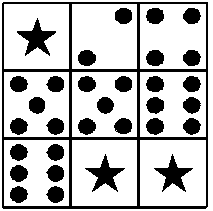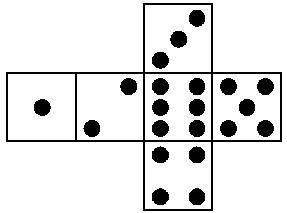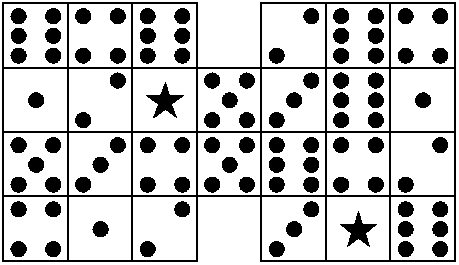ACM International Collegiate
Programming Contest
WORLD FINALS
sponsored by

| 
|
| Figure 1: Sample Dice Maze | Figure 2: Standard Layout of Six-Sided Die |
To move through the maze you must tip the die over on an edge to land on an adjacent square, effecting horizontal or vertical movement from one square to another. However, you can only move onto a square that contains the same number as the number displayed on the top of the die before the move, or onto a "wild" square which contains a star. Movement onto a wild square is always allowed regardless of the number currently displayed on the top of the die. The goal of the maze is to move the die off the starting square and to then find a way back to that same square.
For example, at the beginning of the maze there are two possible moves. Since the 5 is on top of the die, it is possible to move down one square, and since the square to the left of the starting position is wild it is also possible to move left. If the first move chosen is to move down, this brings the 6 to the top of the die and moves are now possible both to the right and down. If the first move chosen is instead to the left, this brings the 3 to the top of the die and no further moves are possible.
If we consider maze locations as ordered pairs of row and column numbers (row, column) with row indexes starting at 1 for the top row and increasing toward the bottom, and column indexes starting at 1 for the left column and increasing to the right, the solution to this simple example maze can be specified as: (1,2), (2,2), (2,3), (3,3), (3,2), (3,1), (2,1), (1,1), (1,2). A bit more challenging example maze is shown in Figure 3.
The goal of this problem is to write a program to solve dice mazes. The input file will contain several mazes for which the program should search for solutions. Each maze will have either a unique solution or no solution at all. That is, each maze in the input may or may not have a solution, but those with a solution are guaranteed to have only one unique solution. For each input maze, either a solution or a message indicating no solution is possible will be sent to the output.

|
| Figure 3: Start at (2,6) with the 3 on top and the 6 facing you. |
END" (without the quotes) as
the name of the maze marks the end of the input.
DICEMAZE1 3 3 1 2 5 1 -1 2 4 5 5 6 6 -1 -1 DICEMAZE2 4 7 2 6 3 6 6 4 6 0 2 6 4 1 2 -1 5 3 6 1 5 3 4 5 6 4 2 4 1 2 0 3 -1 6 DICEMAZE3 3 3 1 1 2 4 2 2 3 4 5 6 -1 -1 -1 END
DICEMAZE1 (1,2),(2,2),(2,3),(3,3),(3,2),(3,1),(2,1),(1,1),(1,2) DICEMAZE2 (2,6),(2,5),(2,4),(2,3),(2,2),(3,2),(4,2),(4,1),(3,1), (2,1),(2,2),(2,3),(2,4),(2,5),(1,5),(1,6),(1,7),(2,7), (3,7),(4,7),(4,6),(3,6),(2,6) DICEMAZE3 No Solution Possible